Marsh D. Applied Geometry for Computer Graphics and CAD
Подождите немного. Документ загружается.


268 Applied Geometry for Computer Graphics and CAD
and
ν(t)= ˙s(t)=
(˙x(t))
2
+(˙y(t))
2
1/2
.
Let t and n denote the unit tangent and normal of C.Sincet(s)·t(s)=1,
differentiation yields t(s)·t
(s) = 0, implying t
(s) is perpendicular to t(s).
Hence t
(s) is parallel to n(s), and so
t
(s)=κ(s)n(s) (10.1)
for some κ(s) called the curvature of C. Since ˙s(t)=ν(t), the chain rule gives
˙
t = νt
, and hence in terms of a general parameter the curvature is given by
˙
t(t)=κ(t)ν(t)n(t) . (10.2)
It follows that
κ = |t
| =
˙
t
/ν .
Further, differentiation of n(s) · n(s)=1givesn(s) · n
(s) = 0, imply-
ing n
(s) is perpendicular to n(s). Hence n
(s) is parallel to t(s), and so
n
(s)=µ(s)t(s)forsomeµ(s). To determine µ(s), differentiate t(s) · n(s)=0
to give t
(s)·n(s)+t(s) · n
(s)=0.Thus
(κ(s)n(s)) ·n(s)+t(s) · (µ(s)t(s)) = κ(s)+µ(s)=0.
Hence µ(s)=−κ(s), and
n
(s)=−κ(s)t(s) .
The chain rule gives ˙n = νn
, and hence in terms of a general parameter
˙n(t)=−κ(t)ν(t)t(t) . (10.3)
Equations (10.2) and (10.3) are known as the Frenet formulae for plane curves.
Theorem 10.1
The curvature of a regular plane curve C(t)=(x(t),y(t)) is
κ(t)=
˙x(t)¨y(t) − ¨x(t)˙y(t)
(˙x(t)
2
+˙y(t)
2
)
3/2
.
Proof
The derivatives of t(t)=
˙
C(t)/ν(t)andν(t)=
˙x(t)
2
+˙y(t)
2
1/2
are
˙
t(t)=
ν(t)
¨
C(t) − ˙ν(t)
˙
C(t)
ν(t)
2
, and
˙ν(t)= (˙x(t)¨x(t)+ ˙y(t)¨y(t))/ ν(t) .
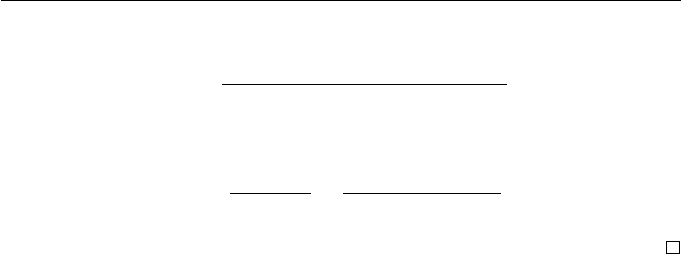
10. Curve and Surface Curvatures 269
So
˙
t(t)=
(˙x(t)¨y(t) − ˙y(t)¨x(t)) (−˙y(t), ˙x(t))
(˙x(t)
2
+˙y(t)
2
)
3/2
.
Then
˙
t(t)=κ(t)ν(t)n(t) implies that
˙
t(t) · n(t)=κ(t)ν(t), and hence
κ(t)=
˙
t(t) · n(t)
ν(t)
=
˙x(t)¨y(t) − ˙y(t)¨x(t)
(˙x(t)
2
+˙y(t)
2
)
3/2
.
The next aim is to show that κ(t) is a measure of the “bendiness” of a
regular plane curve. This is accomplished by showing that, near a given point
on a curve, the curve is well approximated by a circle. The radius of that circle
measures the extent to which the curve bends. It will be shown that κ(t)isthe
reciprocal of the radius.
To this end, consider three neighbouring points C(t−δt), C(t), and C(t+δt)
of a regular curve C.Letx =(x, y). Suppose (x−c)·(x−c)−r
2
=0(c constant)
is the unique circle through the points, and let
σ(t)=(C(t) − c) · (C(t) − c) − r
2
.
Then σ(t − δt)=σ(t)=σ(t + δt) = 0, and by Rolle’s theorem, there exist
t
0
∈ (t − δt, t)andt
1
∈ (t, t + δt) such that ˙σ(t
0
)= ˙σ(t
1
) = 0. A further
application of Rolle’s theorem implies that there exists a t
2
∈ (t
0
,t
1
) such that
¨σ(t
2
)=0.Thus
˙σ(t
0
)=2(C(t
0
) − c) ·
˙
C(t
0
)=0,
˙σ(t
1
)=2(C(t
1
) − c) ·
˙
C(t
1
)=0,
¨σ(t
2
)=2(C(t
2
) − c) ·
¨
C(t
2
)+2
˙
C(t
2
) ·
˙
C(t
2
)=0.
Letting δt → 0, then the three points converge to the point C(t), and t
0
,t
1
,t
2
all converge to t so that
2(C(t) − c) ·
˙
C(t)=0, (10.4)
2(C(t) − c) ·
¨
C(t)+2
˙
C(t) ·
˙
C(t)=0. (10.5)
The circle converges to the circle, known as the osculating circle, which best
fits C at the point C(t). Equation (10.4) implies that C(t) −c is perpendicular
to the tangent vector and hence parallel to the normal vector. Thus C(t) −c =
µn(t)forsomeµ. Substituting in (10.5) gives
2(µn(t)) ·
¨
C(t)+2
˙
C(t) ·
˙
C(t)=0. (10.6)
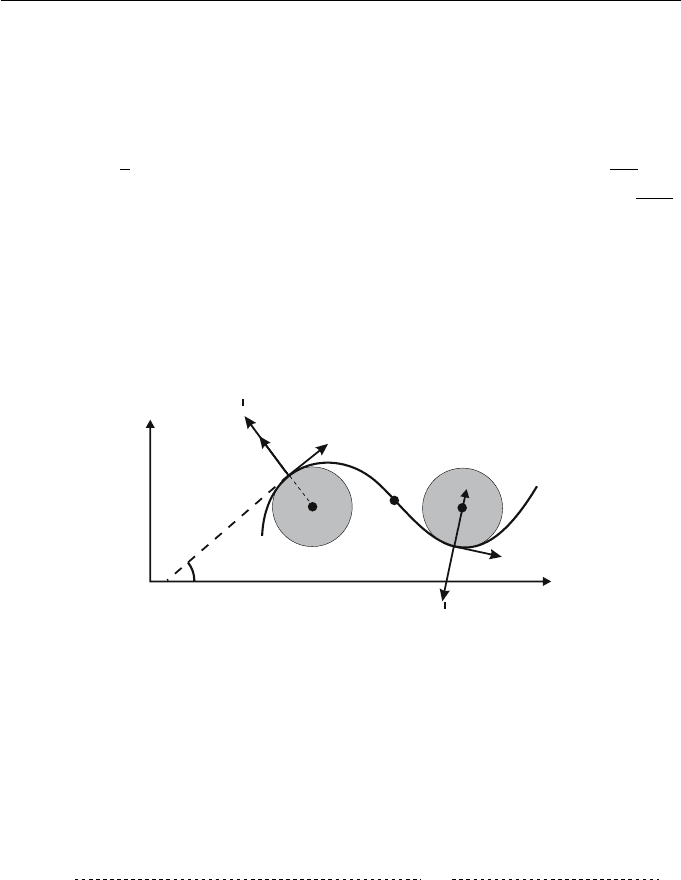
270 Applied Geometry for Computer Graphics and CAD
Since
˙
C = νt and
˙
t = νκn, it follows that
¨
C =˙νt+ν
˙
t =˙νt+ν
2
κn. Substituting
for
˙
C and
¨
C in (10.6) yields
2(µn) ·
˙νt + ν
2
κn
+2(νt) · (νt)=2
µν
2
κ + ν
2
=0.
Hence µ = −
1
κ
and the centre of the osculating circle is c = C(t)+
1
κ(t)
n(t),
called the centre of curvature. The osculating circle has radius ρ(t)=
1
|κ(t)|
,
called the radius of curvature. Since the curve is well approximated by the
osculating circle, the curvature κ(t) measures the bendiness of the curve at
C(t). When |κ(t)| is small, ρ(t) is large and therefore the curve is fairly flat,
whereas when |κ(t)| is large, ρ(t) is small and the curve bends a fair amount.
When κ(t) > 0, c lies on the same side of the curve as n,andwhenκ(t) < 0,
c lies on the opposite side of the curve to n, as shown later in Figure 10.1.
t
t
k = 0
t
t
x
y
q
n
c
c
n
k > 0
k < 0
Figure 10.1 Curvature of a plane curve
Example 10.2
Consider the ellipse C(θ)=(a cos θ, b sin θ). Then
˙
C(θ)=(−a sin θ, b cos θ)and
¨
C(θ)=(−a cos θ, −b sin θ), giving
κ(θ)=
(−a sin θ)(−b sin θ) − (b cos θ)(−a cos θ)
(−a sin θ)
2
+(b cos θ)
2
3/2
=
ab
a
2
sin
2
θ + b
2
cos
2
θ
3/2
.
The graph of the curvature for a =3,b =2,and0≤ θ ≤ 2π is shown in
Figure 10.2. The curvature has maximum values at θ =0andθ = π,and
minimum values at θ = π/2andθ =3π/2. The corresponding points on the
ellipse are easily identified.
Suppose κ(s) is the curvature function of a unit speed curve C(s)=
(x(s),y(s)). Then since t(s) is a unit vector, t(s)=(cosθ(s), sin θ(s)) where
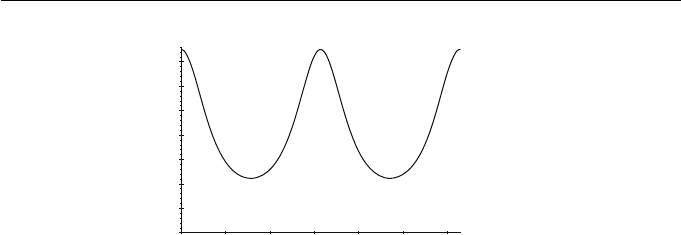
10. Curve and Surface Curvatures 271
6
543210
0.7
0.6
0.5
0.4
0.3
0.2
0.1
0
Figure 10.2 Curvature function for the ellipse C(θ) = (3 cos θ, 2sinθ)
θ(s) is the angle the tangent vector makes with the x-axis (see Figure 10.1).
Then n(s)=(−sin θ(s), cos θ(s)), t
(s)=θ
(s)(−sin θ(s), cos θ(s)) = θ
(s)n(s),
and comparison with (10.1) gives
κ(s)=θ
(s) . (10.7)
So curvature is the rate of change of the tangent (when the curve is unit speed).
This fact is used in Theorem 10.3. When κ>0, n and t
have the same
direction, and when κ<0, n and t
have opposite directions, as shown in
Figure 10.1.
Theorem 10.3
Let κ(s) be a continuous function. Then there exists a planar unit speed curve
C(s)=(x(s),y(s)) with curvature κ(s). The curve is unique up to its position
and orientation in the plane.
Proof
Suppose κ(s) is the curvature function of a unit speed curve C(s)=(x(s),y(s)),
and suppose (x(s
0
),y(s
0
)) = (x
0
,y
0
)and(x
(s
0
),y
(s
0
)) = (x
0
,y
0
). Let t(s)=
(x
(s),y
(s)) = (cos θ(s), sin θ(s)). Then (10.7) gives
θ(s)=θ(s
0
)+
s
s
0
κ(u) du ,
where θ(s
0
)=tan
−1
(y
0
/x
0
)ifx
0
=0,andθ(s
0
)=π/2ifx
0
=0.Thus
x(s)=x
0
+
s
s
0
cos θ(u) du, y(s)=y
0
+
s
s
0
sin θ(u) du . (10.8)
Equations (10.8) show the existence of a unit speed curve with curvature κ(s).
For a given initial point (x
0
,y
0
) and tangent direction (x
0
,y
0
), the constructed

272 Applied Geometry for Computer Graphics and CAD
curve is uniquely determined. So all unit speed curves with curvature κ(s)can
be mapped to one another by a planar transformation consisting of a rotation
which aligns the initial tangent directions of the curves, and a translation which
maps the initial point of one curve to the initial point of the other.
The curvature κ(s) is often referred to as the natural or intrinsic equation
of a curve.
Remark 10.4
An alternative proof of Theorem 10.3 is obtained by noting that the identity
t
(s)=κ(s)n(s) yields a system of ordinary differential equations
x
(s)=−κ(s)y
(s)
y
(s)=κ(s)x
(s)
. (10.9)
The existence of solutions to this system is a result in the theory of differential
equations. The system can be converted to a second order differential equation.
Let X(s)=x
(s)andY (s)=y
(s), then (10.9) gives the system of first order
differential equations
X
(s)=−κ(s)Y (s)
Y
(s)=κ(s)X(s)
. (10.10)
Differentiating the first equation gives X
(s)=−κ
(s)Y (s) − κ(s)Y
(s)and
substituting Y
= κ(s)X(s)andY (s)=−X
(s)/κ(s) yields
X
(s) −
κ
(s)
κ(s)
X
(s)+κ(s)
2
X(s)=0. (10.11)
Equation (10.11) can be solved for X(s) and the result used to determine Y (s).
Finally, X(s)andY (s) are integrated to obtain x(s)andy(s).
For fairly simple choices of κ(s), Equations (10.11), (10.9), or (10.8) can
be solved to give analytical solutions for x(s)andy(s) using standard tech-
niques. For more complicated κ(s), numerical integration methods can be used
to evaluate the integrals (10.8).
Example 10.5
Let κ(s)=1/R,(x(0),y(0)) = (R, 0), and (x
(0),y
(0)) = (0, 1). Following
the proof of Theorem 10.3, s
0
=0,α = π/2, and θ(s)=π/2+
s
0
1/R du =

10. Curve and Surface Curvatures 273
π/2+s/R.So
x(s)=R +
s
0
cos (π/2+u/R) du = R +
s
0
−sin(u/R) du
= R +(R cos(s/R) − R)=R cos(s/R) .
Similarly,
y(s)=
s
0
sin (π/2+u/R) du =
s
0
cos (u/R) du = R sin(s/R) .
Thus (x(s),y(s)) = (R cos(s/R),Rsin(s/R)). The curve is a circle radius |R|.
Alternatively, κ(s)=1/R, κ
(s) = 0, and (10.11) gives
X
(s)+
1
R
2
X(s)=0,
which has solutions of the form X(s)=A cos(s/R)+B sin(s/R). The initial
condition X(0) = x
(0) = 0 implies A =0.Thusx
(s)=B sin(s/R), and
integrating gives x(s)=−BRcos(s/R). The initial condition x(0) = R yields
B = −1andx(s)=R cos(s/R). Finally, Y (s)=−X
(s)/κ(s)=
1
R
cos(s/R),
and so y(s) = sin(s/R).
Example 10.6
Let κ(s)=as,(x(0),y(0)) = (0, 0), and (x
(0),y
(0)) = (1, 0). Then, s
0
=0,
α =0,θ(s)=
s
0
au du =
1
2
as
2
,and
x(s)=
s
0
cos
1
2
as
2
du, y(s)=
s
0
sin
1
2
au
2
du .
The integrals in the above expressions are known as Fresnel integrals. The curve
obtained is called a clothoid or Cornu spiral, and is illustrated in Figure 10.3.
EXERCISES
10.1. Compute the unit tangent vector, unit normal vector, and curvature
for each of the following curves:
(a) catenary: C(t)=(t, c cosh(t/c));
(b) cycloid: C(t)=(t − sin t, 1 − cos t), t ∈ [−π,π];
(c) logarithmic spiral: C(t)=
ae
bt
cos t, ae
bt
sin t
.
10.2. Determine the curvature κ(t)ofthecurve(t, t
3
). Sketch the curve,
and indicate the parts of the curve where κ>0andκ<0.
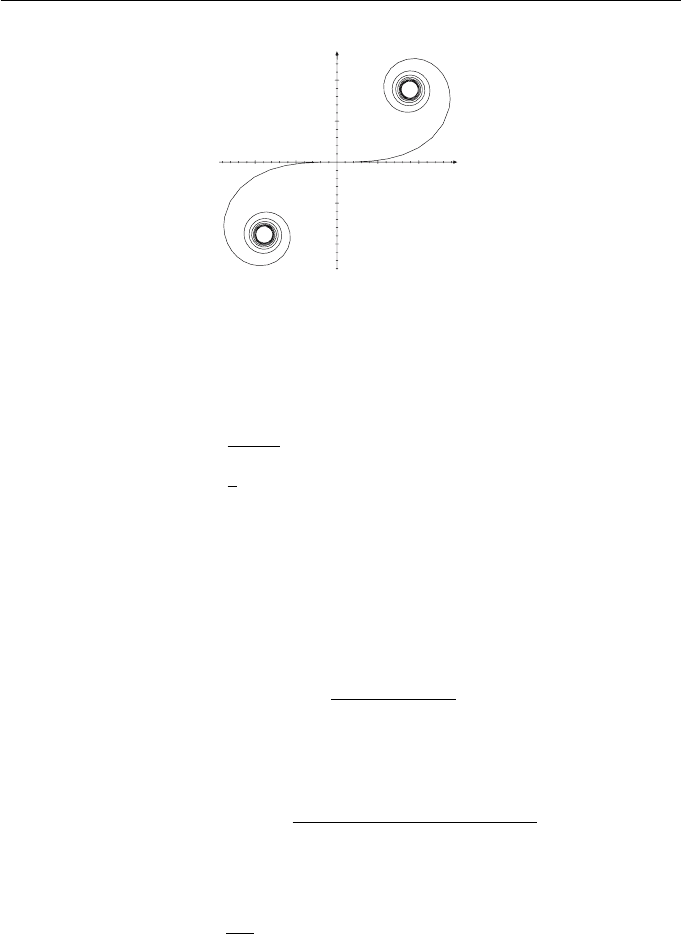
274 Applied Geometry for Computer Graphics and CAD
-1
-0.5
0
0.5
1
y
-1
-0.5 0.5
1
x
Figure 10.3 Clothoid or Cornu spiral
10.3. Determine the parametrization of the plane unit speed curve with
curvature
(a) κ(s)=1/
√
1 − s
2
;
(b) κ(s)=1/
√
s;
(c) κ(s)=−a/(a
2
+ s
2
)wherea is a positive real number.
10.4. Show that a regular plane curve with curvature κ = 0 is a straight
line.
10.5. Show that a plane curve with polar coordinates r = r (θ)forθ ∈ [a, b]
(so (x(θ),y(θ)) = (r(θ)cosθ, r(θ)sinθ)) has arclength
b
a
r (θ)
2
+ r
(θ)
2
dθ ,
and curvature
κ (θ)=
2r
(θ)
2
− r (θ) r
(θ)+r (θ)
2
r (θ)
2
+ r
(θ)
2
3/2
.
10.6. Let C(t) be a regular plane curve such that κ(t) =0.Thecurve
E(t)=C(t)+
1
κ(t)
n(t) is called the evolute of C(t). The evolute is
the locus of the centres of curvature of C(t). Determine the evolute
of the following curves:
(a) cycloid: C(t)=(t +sint, 1 − cos t).
(b) ellipse: C(t)=(a cos t, b sin t).
10.7. Consider the ellipse C(t) = (3 cos t, 2sint), t ∈ [0, 2π].

10. Curve and Surface Curvatures 275
(a) Determine the parametric equation of the offset of the ellipse at
a distance d.
(b) Determine κ and ˙κ. Hence calculate the parameter values, and
the corresponding points on the ellipse, where the curvature is
at a maximum or a minimum.
(c) Obtain the maximum and minimum values of curvature. Deduce
the maximum radius d that a ball cutter can be in order to cut
the shape of the ellipse (assuming the cutter is in the interior of
the ellipse).
10.2 Curvature and Torsion of a Space Curve
Let C(t)=(x(t),y(t),z(t)) be a regular parametric space curve defined on an
interval I (open or closed). As for the case of plane curves, the curve C(t) and its
unit speed reparametrization C(t(s)) are both denoted by C, and differentiation
with respect to a general and unit speed parameter are distinguished by · and
respectively. The speed of a space curve is ν(t)=
˙x(t)
2
+˙y(t)
2
+˙z(t)
2
1/2
,
and the chain rule for differentiation yields
˙
C =νC
.Theunit tangent vector
is defined to be
t = C
=
˙
C/ν . (10.12)
The vector k = t
=
˙
t/ν is called the curvature vector, and its magnitude
κ = |k| = |t
| =
˙
t
ν,
is called the curvature of C. The curvature measures the rate of change of
the tangent t along the curve with respect to arclength. At a given point of a
space curve, there are infinitely many vectors which are perpendicular to t,and
therefore normal to the curve. Since t is a unit vector, t · t =1andt · t
=0.
Hence k = t
is perpendicular to t. At every point of the curve for which κ =0
there is a well-defined unit vector
n = t
/|t
| =
˙
t
˙
t
called the principal normal. It follows that
t
= κn and
˙
t = κνn . (10.13)
If κ = 0 then the principal normal is not well defined.
At a point p on the curve C, the plane containing point p, and directions
t and n is called the osculating plane. The unit vector b = t × n, which is
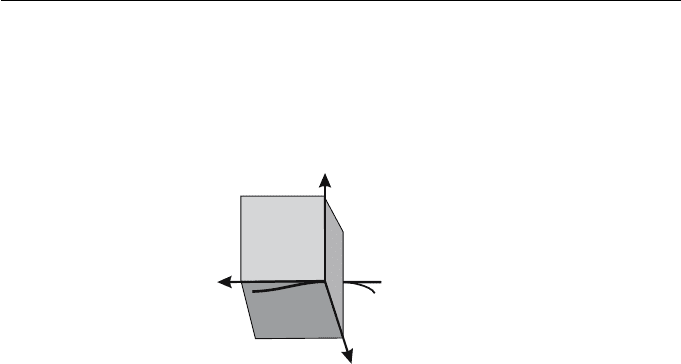
276 Applied Geometry for Computer Graphics and CAD
perpendicular to the osculating plane, is called the binormal vector. The plane
containing p, n,andb is called the normal plane, and the plane containing p, t,
and b is called the rectifying plane. The planes are depicted in Figure 10.4. The
t
n
b
Normal
plane
Normal
plane
Osculating
plane
Osculating
plane
Rectifying
plane
Rectifying
plane
Figure 10.4 Osculating, normal and rectifying planes of a space curve
mutually perpendicular unit vectors t, n, and b are called the Frenet frame,
and they satisfy
t · t =1, n · n =1, b · b =1,
t · n =0, t · b =0, n · b =0. (10.14)
Any vector v can be expressed in terms of the frame: v = v
1
t+v
2
n+v
3
b.Then
v · t =(v
1
t + v
2
n + v
3
b) · t = v
1
(t · t)+v
2
(n · t)+v
3
(b · t)=v
1
. Similarly,
v
2
= v ·n and v
3
= v ·b.Sov =(v · t) t +(v · n) n +(v · b) b. The expression
is called the orthonormal expansion of v with respect to the Frenet frame.
Differentiating the first row of equations of (10.14) yields
t ·
˙
t =0, n · ˙n =0, b ·
˙
b =0. (10.15)
The orthonormal expansion of
˙
b with respect to the Frenet frame gives
˙
b =(
˙
b · t)t +(
˙
b · n)n +(
˙
b · b)b =(
˙
b · t)t +(
˙
b · n)n .
Differentiating b · t =0gives
˙
b · t + b ·
˙
t = 0, and (10.13) implies
˙
b · t = −b ·
˙
t = −b·(κνn)=0.
Hence
˙
b =(
˙
b · n)n and therefore
˙
b and b
are parallel to n.Thusb
= −τn
for some τ called the torsion,and
˙
b = b
ν = −τνn . (10.16)

10. Curve and Surface Curvatures 277
b
is called the torsion vector . Torsion measures the bending of the curve out
of the osculating plane, and can be computed using τ = −
˙
b · n
/ν (also see
Theorem 10.9).
Differentiating n · b =0 yields n ·
˙
b + ˙n · b =0, and (10.16) implies
˙n · b = −n ·
˙
b = −n·(−τνn)=τν . (10.17)
Likewise, differentiating n · t =0 gives n ·
˙
t + ˙n·t =0, and (10.13) gives
˙n · t = −n ·
˙
t = −n · (κνn)=− κν . (10.18)
The orthonormal expansion for ˙n is
˙n =(˙n · t)t+( ˙n · n)n+( ˙n · b)b ,
and it follows from (10.15), (10.17), and (10.18) that
˙n = −κνt+τνb . (10.19)
Together Equations (10.13), (10.16), and (10.19) yield the following theorem
which expresses the vectors
˙
t, ˙n,
˙
b in terms of the Frenet frame.
Theorem 10.7 (Frenet–Serret Formulae)
Let C(t) be a regular curve with κ(t) =0.Then
˙
t(t)=κ(t)ν(t)n(t) ,
˙n(t)=−κ(t)ν(t)t(t)+τ(t)ν(t)b(t) ,
˙
b(t)=−τ(t)ν(t)n(t) .
Example 10.8
Consider the twisted cubic C(t)=(t,
1
2
t
2
,
1
6
t
3
). Then
˙
C(t)=(1,t,
1
2
t
2
)and
ν(t)=
1
2
+ t
2
+
1
2
t
2
1/2
=
2+t
2
2
. Hence
t =
˙
C(t)
˙
C(t)
=
2
2+t
2
,
2t
2+t
2
,
t
2
2+t
2
.
Thus
˙
t =
−
4t
(2+t
2
)
2
,
4−2t
2
(2+t
2
)
2
,
4t
(2+t
2
)
2
,
˙
t
=
2
2+t
2
,and
n =
˙
t
˙
t
=
−
2t
2+t
2
,
2 − t
2
2+t
2
,
2t
2+t
2
.
